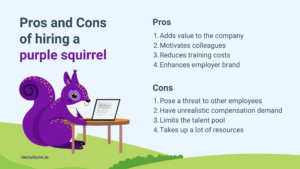Do you know the feeling when you’ve struck gold?
Well, that’s exactly how recruiters feel when they find the perfect candidate, known better as a purple squirrel.
Finding and hiring these standout performers may sound fancy, but honestly, a lot of effort goes into it, and you have to be prepared for that.
Keep reading to know all that you need to know about the purple squirrel candidate hunt.
What is a purple squirrel?
A purple squirrel is a recruitment term for a candidate who perfectly matches the job description.
This top performer ticks all the boxes in your list of requirements. They are so rare that they almost sound like myths.
In simple terms, a purple squirrel is your dream hire. They have all the skills you need and the exact experience you’re looking for and fit seamlessly into your company’s culture.
You may also like: Who is a purple unicorn? Here’s what the recruiters need to know
Pros and cons of hiring a purple squirrel

-
Advantages:
1. Adds value to the company
Purple squirrels carry a lot of expertise and unique skills with them which can significantly enhance a company’s performance.
They bring in fresh perspectives and innovative ideas.
That, mixed with their ability to integrate into various roles and departments effortlessly, allows them to contribute towards the growth of the organization from day one.
2. Motivates colleagues
Having a purple squirrel on the team can inspire other employees.
Your whole group may see their high level of competency and dedication and want to be like them. This creates a culture of excellence and healthy competition within the company.
In fact, these top performers can be great mentors. They can share their knowledge and push their colleagues to achieve more, leading to the holistic development of the team.
3. Reduces training costs
Since purple squirrels already have the desired skill set and relevant experience, they need very little training. This reduction in learning time and resources saves the company a lot of money.
In some cases, these perfect candidates might request training opportunities in particular fields of work. It’s best to fulfill those demands because they will yield a huge return on your investments.
Also read: 10 things to keep in mind while training recruiters for your search agency
4. Enhances employer branding
As you may have heard, Like attracts like!
Being a purple squirrel’s top choice can make you stand out of the crowd.
When word gets out that your company employs top-tier talent, other high-caliber candidates also get attracted to working with you.
Soon enough, you will have a list of such top performers lining up to join your organization.
Also read: Anna Bertoldini’s take on building a solid employer brand
-
Disadvantages
1. Pose a threat to other employees
While purple squirrels can drive a team forward, they can also pose a threat to other employees.
Their exceptional abilities and performance levels may unintentionally create feelings of insecurity, inadequacy, or competition among colleagues, potentially leading to workplace tension.
This can lead to jealousy or office rivalries.
To avoid it, it’s important to carefully manage these dynamics and maintain a positive work environment.
2. Have unrealistic compensation demands
Purple squirrels are in huge demand in the market, and hence, they know their worth.
These perfect candidates often have unrealistic salary expectations. Meeting these demands can strain your recruitment budget and might create pay disparities within your team.
Before deciding, you have to weigh these costs against the potential benefits they bring.
3. Limits talent pool
Sometimes, when you focus too much on finding the purple squirrel, you may ignore other potential candidates.
You might reject an applicant who, with the right training and guidance, could have been a perfect choice for your position.
Instead of focusing on finding the ideal candidate, focus on those who have the potential to turn into one.
Read more: How to build a diverse talent pipeline? [5 best strategies]
4. Takes up a lot of resources
The search for a purple squirrel is not easy. It takes a lot of time and effort to find the perfect applicant and convince them to join your team.
You have to invest a lot of energy into candidate sourcing, screening, and negotiating with them. This can divert your attention and resources away from other important hiring activities.
4 solid tips to hire purple squirrels

1. Study your target
To find a purple squirrel, you first have to study the market.
Knowing who your perfect candidate is tells you where to look for them. You have to create an ideal persona for your dream hire. Include everything from their skills, experience, and knowledge to the social media platform they use the most.
To do this, start analyzing your top performers and see what makes them successful. Then, use this information to create a detailed profile of your star recruit.
2. Separate needs from wants
Having a long, unrealistic list of required skills can sometimes scare the candidates. That’s why you should differentiate the must-have skills from nice-to-have skills.
A clear and realistic job description helps attract candidates who meet the essential requirements while being open to those who can grow into the role.
3. Focus on recruitment marketing
Most of the time, purple squirrels are passive candidates. So you have to be very good at recruitment marketing if you want them to notice you.
Make your job advertisements so attractive that no one can ignore them. While writing job descriptions, use a tone that resonates with your company’s culture. Showcase the competitive compensation and benefits that come with the job.
Also, establish a strong online presence for your employer brand.
Promote what makes your company a great place to work. Make use of job boards, social networking sites, content marketing, email marketing, and other marketing tools that best suit your brand.
You may also like: Top 8 recruiting marketing ideas to attract the best candidates
4. Improve your office culture
Purple squirrels hold the work environment in high regard while choosing a new workplace.
Create an atmosphere that values diversity, encourages professional development, and supports a healthy work-life balance.
Ensure that your employees feel fulfilled and secure while working. See if they have any concerns or suggestions for improving the workplace.
Also read: How to change your recruiting strategy to hire more purple squirrels?
Are purple squirrels really worth the hype?
The correct answer to this question is—YES and NO.
You cannot deny the fact that finding the perfect fit for the job is like finding your soulmate.
But what will you do if all the employees working the job are perfect? Who will you train? To whom will you provide growth opportunities?
Plus, eliminating the risk of the threat posed by purple squirrels is not an easy task.
Such a risk will only result in jealousy and insecurities between the employees.
Hence, your first priority should always be to find talented candidates who are ready to work with utmost dedication and passion.
Who knows, you may become the employer who doesn’t hire purple squirrels but the one who turns regular employees into one.
You may also like: The battle between purple squirrels & normal squirrels: who should recruiters hire & why?
Frequently asked questions
1. How important are referrals in recruiting purple squirrels?
Referrals are an incredibly valuable asset when recruiting purple squirrels.
Your employees and industry contacts already understand your company’s culture and needs.
Based on that knowledge, they can refer candidates from their network who are perfect for the job.
2. What are some red flags to watch for when evaluating potential purple squirrels?
Just because a candidate has all the required skills and experience doesn’t mean they will be a good fit for your company. You have to consider their personality as well.
Watch out for applicants who seem overconfident or have unrealistic expectations. They might be arrogant and have difficulty working with others.
Look at past job tenures. If they didn’t last long at previous companies, there is a good chance they won’t last much at yours too.
3. How can I ensure that a purple squirrel will fit into my company’s culture?
To ensure that the candidate is a good cultural fit for your organization, use cultural alignment assessments like behavioral interviews, situational judgment tests, and trial periods during your recruitment process.
Involving applicants in team activities during the interview process can also provide insights into how well they will fit with your team.




